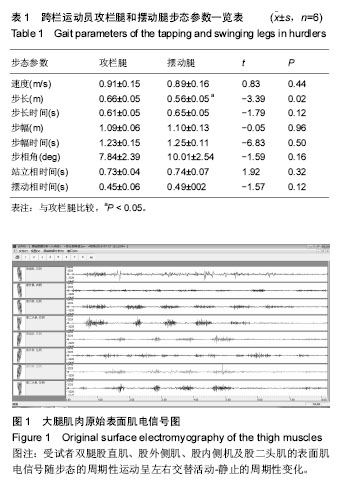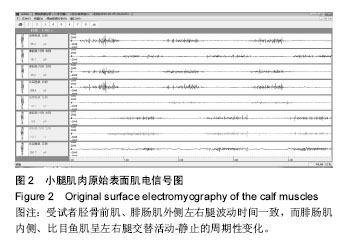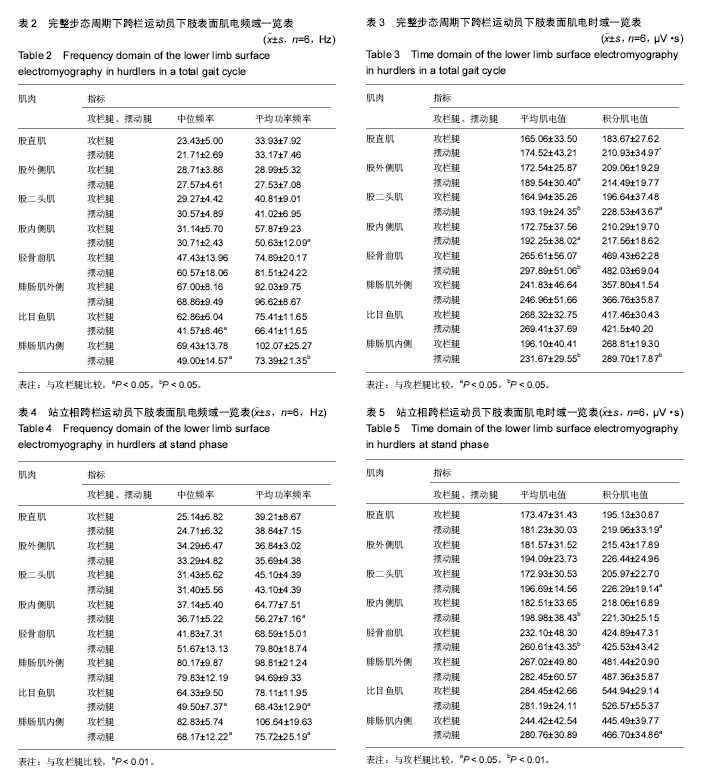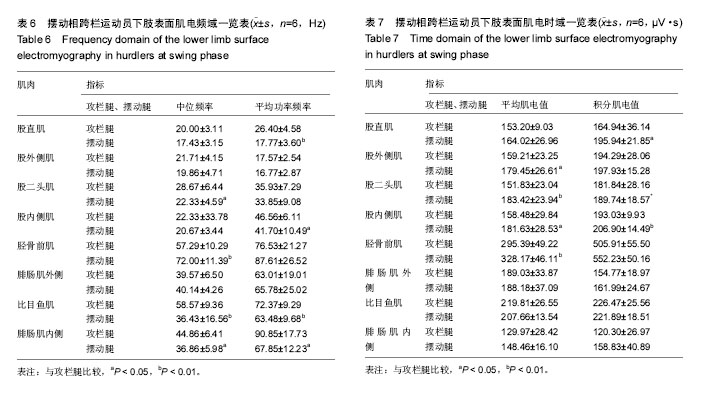中国组织工程研究 ›› 2017, Vol. 21 ›› Issue (24): 3851-3857.doi: 10.3969/j.issn.2095-4344.2017.24.014
• 肌肉肌腱韧带组织构建 tissue construction of the muscle, tendon and ligament • 上一篇 下一篇
基于步态周期下跨栏运动员步态及下肢表面肌电特征分析
宋 倩1,2,彭 莉1,秦渝珂1,裴希俊1
- 1西南大学体育学院,国家体育总局体质评价与运动机能监控重点实验室,重庆市 400715;2重庆三峡学院,体育与健康学院 404000
Gait and surface electromyography characteristics in hurdle athletes in a total gait cycle
Song Qian1, 2, Peng Li1, Qin Yu-ke1, Pei Xi-jun1
- 1School of Sports Science and Physical Education, Southwest University, the Key Laboratory of Physical Assessment and Motor Function in General Administration of Sport of China, Chongqing 400715, China; 2School of Sports and Health, Chongqing Three Gorges University, Chongqing 404000, China
摘要:
文章快速阅读:
.jpg)
文题释义: 步态周期:是指将受试者的右足足跟接触数字步道的瞬间视为起点,待该侧足跟再次接触数字步道时,即为一个步态周期,步态周期由站立相和摆动相组成。 表面肌电信号:是指从人体骨骼肌表面通过电极记录下来的神经肌肉活动时发放的生物电信号,反映了神经和肌肉的活动状态,表面肌电信号由肌电频域和肌电时域组成。
摘要
背景:近年来对跨栏运动员的研究方法主要采用录像解析结合DLT算法获取技术参数,对跨栏运动员正常步行下步态和表面肌电特征的研究甚少。
目的:实验旨在完整步态周期下,探讨跨栏运动员步态及下肢表面肌电特征的变化。
方法:男性专业跨栏运动员8名在步道上分别进行步态和下肢表面肌电测试,运用数理统计法分析步态、下肢表面肌电信号的差异。
结果与结论:①跨栏运动员步态参数无显著性差异(除步长外);②完整步态周期中,随着步态的周期性变化,下肢同名肌肉表面肌电呈左右交替的肌电活动;③下肢肌群中攻栏腿的中位频率和平均功率频率值大于摆动腿(除股二头肌、胫骨前肌及腓肠肌外侧),但攻栏腿的平均肌电值和肌电积分值小于摆动腿;④站立相阶段,下肢各肌群攻栏腿的中位频率和平均功率频率值大于摆动腿(除胫骨前肌),但攻栏腿的平均肌电值和肌电积分值小于摆动腿(除比目鱼肌);⑤摆动相阶段,下肢各肌群攻栏腿的中位频率和平均功率频率值大于摆动腿(除胫骨前肌及腓肠肌外侧),但攻栏腿的平均肌电值和肌电积分值小于摆动腿(除比目鱼肌);⑥结果显示:完整步态周期中,跨栏运动员步态参数差异不显著,下肢同名侧肌肉表面肌电信号随步态的周期性运动呈左右交替的肌电活动,各肌群攻栏腿和摆动腿表面肌电频域和时域具有不同程度的差异,且攻栏腿肌肉力量小于摆动腿。
中图分类号:




.jpg)